Customs, Beliefs and Superstitions
Traditions both ancient and modern.
Most customs were carried out at important times in people's lives like at birth, marriage and death.A Birth
Rituals which were carried out to protect a newly born baby. A fire or burning peat was carried three times around the baby and its mother.
Bread or a bannock and cheese were placed in the baby's basket to keep the fairies happy.
A brooch made of iron called a witch pin was fastened to babies' clothes to protect them from witches.
A "Luck Penny" was slipped into a baby's hand when a person saw them for the first time.
At a Wedding
A few days before a wedding the bride and groom were seized by their friends, their socks and stockings were removed and their feet were plunged into water then covered with soot or blacking. In more recent times treacle and cocoa or even tar and feathers, replaced the soot and the bride and groom were sometimes tied to lamp-posts or driven around the town on a cart. This was called feet washing or blackening.
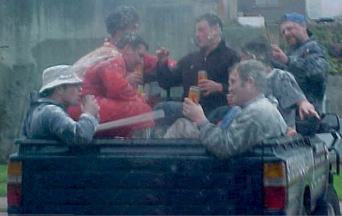
The tradition of the "blackening" still carries on in some places. The old horse and cart has been replaced with a pick-up truck in this photograph taken in Macduff in 2008. The groom and his pals enjoy the fun as they ride around the town a few days before the wedding.
At the wedding, shortbread or oatcakes were broken over the bride's head then given out to the guests. When they returned to their home, before entering the house, the bride stepped over a burning peat.
When Someone Died
When a death occurred one of the first things to be done was to shut in all of the cats and hens. It was believed that should they jump over the corpse the next person they met would go blind, or suffer some similar misfortune.
Mirrors were covered.
If bees were kept they were told about the death.

In the 1700s funerals often took place at night under candle light.
A coin was often placed in the coffin to pay the ferryman who they believed transported the body to heaven.
Broonies, Fairies and Spirits
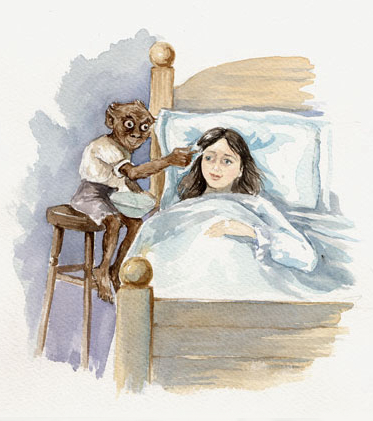
Though ugly and quite fearsome in appearance, ancient mythical tales describe "Broonies" or "Brownies" as helpful little creatures and that is why the name was adopted by the junior division of the Girl Guides. They occupy old houses and help keep places clean and tidy. On farms they help with day to day chores. The illustration shows a brownie looking after a sick young girl as she lies in her bed. Tales and legends have it that brownies are particularly helpful to those who believe they exist.
Broonies were spirits who lived in houses. They were believed to be about 3 feet tall and brown in colour. If they were treated well by being left food and drink they would help around the house, but, if they were annoyed, they might break dishes, slam doors and eventually leave the house.
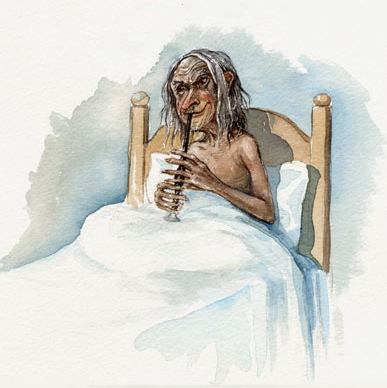
Changelings, according to ancient myths and legends, were left by fairies in place of kidnapped human babies.
It was believed that fairies took children to the Land of Light, a care-free world where everyone played, danced and sang the days away. The illustration shows the changeling from an ancient tale who was left in place of a fisherman's baby. The mother refused to believe her child had been taken until one day she found the changeling in bed playing on a pipe chanter.
Kelpies
These were bad fairies found in dangerous rivers or deep pools. They took the form of water horses and were blamed when people drowned.
Customs and traditions of the Farming Folk
The Clyack SheafMany traditions grew up around the last sheaf of corn to be cut at harvest time. The word "Clyack" comes from the Gaelic "caileag" which means a girl.
The sheaf would be cut by the youngest person present, then bound by three bands at the top, middle and bottom instead of just one, which made it look like the shape of a person. It was then carried to the house where it was sometimes dressed in women's clothes or decorated with ribbons. At the Harvest feast it would be put on display and it would sometimes be used as a partner to lead off the dancing. On Christmas morning, it would be fed to a mare in foal, or the oldest cow, or shared with all the animals on the farm.
Customs and traditions of the Fishing Folk
Fisher folk were very superstitious and there were long lists of things that they believed brought bad luck.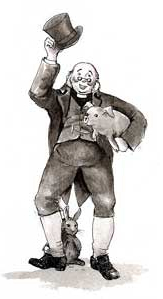
The Minister with a pig and a rabbit. Not a welcome sight for a fisherman about to go to sea!
Pigs, rabbits and salmon were all thought to be unlucky and if any of these were found on board a boat the fishermen refused to go to sea. They even made up nicknames for them so that they did not have to say their names aloud. Rabbits were called "map-irons", salmon "caul-irons" and pigs, more obviously, "grunters".
Fishermen did not allow any women or kirk ministers on board a boat as they thought this would lead to a disaster at sea.
Fishers never whistled into the wind and if they accidently put their "ganzie" (jumper) on inside-out, they would leave it like for the rest of the trip because they thought to take it off and put it back on the right way would bring bad luck.
Iron or things made of metal were thought to bring good luck and sometimes horseshoes were hung on the masts of the boats or coins placed in the men's socks before they went to sea.
Task: Can you think of any superstitions that people still have today?
Beliefs and Faith
For many years drinking whisky was very much a part of some fishermen's lives and drunken fights were quite common when the men came ashore. The women felt this had to be stopped and formed The Temperance Societies. These societies aimed to stop people drinking alcohol of any sort. They marched through the towns and villages to persuade others to join them often accompanied by Flute Bands. Temperance marches still take place in some of the fishing villages today.
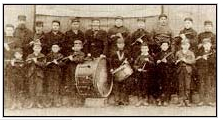
The Broadsea Temperance Flute Band, 1881.
Many of the fisher communities are deeply religious and halls of worship have been built in all the villages. Sunday is a day of worship for the whole village and everyone dresses in their "Sunday Best." Some folk might go to the Kirk while others gather at the meeting hall or attend a prayer meeting in someone's house.
Fishing boats never sailed on a Sunday and always waited until after midnight, "Back o' Sunday", before they went to sea. It was quite a spectacle when the fleets left harbour with their lights aglow in the early hours of a Monday morning.
Task: Now that you have read about how the fisher folk lived and worked in the past, think of how the fishermen's lives have changed today.

